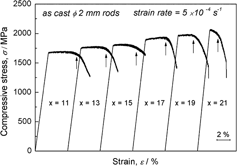Crossref Citations
This article has been cited by the following publications. This list is generated based on data provided by
Crossref.
Li, Y.H.
Zhang, W.
Dong, C.
Qiang, J.B.
Xie, G.Q.
Fujita, K.
and
Inoue, A.
2012.
Glass-forming ability and corrosion resistance of Zr-based Zr–Ni–Al bulk metallic glasses.
Journal of Alloys and Compounds,
Vol. 536,
Issue. ,
p.
S117.
Li, YanHui
Zhang, Wei
Dong, Chuang
and
Makino, Akihiro
2012.
Effects of Cu, Fe and Co addition on the glass-forming ability and mechanical properties of Zr-Al-Ni bulk metallic glasses.
Science China Physics, Mechanics and Astronomy,
Vol. 55,
Issue. 12,
p.
2367.
Li, Yan Hui
Zhang, Wei
Dong, Chuang
and
Makino, Akihiro
2013.
Glass-Forming Ability and Mechanical Properties of Zr-Ni-Al Bulk Metallic Glasses with High Zr Content.
Materials Science Forum,
Vol. 750,
Issue. ,
p.
306.
Liang, Shunxing
Yin, Lixia
Jing, Ran
Zhang, Xinyu
Ma, Mingzhen
and
Liu, Riping
2013.
Deformation mechanisms of a ZrTiAlV alloy with two ductile phases.
Journal of Materials Research,
Vol. 28,
Issue. 19,
p.
2715.
Li, Y.H.
Zhang, W.
Dong, C.
Kawashima, A.
Makino, A.
and
Liaw, P.K.
2013.
Effects of cryogenic temperatures on mechanical behavior of a Zr60Ni25Al15 bulk metallic glass.
Materials Science and Engineering: A,
Vol. 584,
Issue. ,
p.
7.
Chu, Elza
and
Sidorenko, Alexander
2013.
Surface Reconstruction by a “Grafting Through” Approach: Polyacrylamide Grafted onto Chitosan Film.
Langmuir,
Vol. 29,
Issue. 40,
p.
12585.
Zhang, Wei
Guo, Hai
Li, Yanhui
Wang, Yingmin
Wang, Hao
Chen, Mingwei
and
Yamaura, Shinichi
2014.
Formation and properties of P-free Pd-based metallic glasses with high glass-forming ability.
Journal of Alloys and Compounds,
Vol. 617,
Issue. ,
p.
310.
Hua, Nengbin
and
Chen, Wenzhe
2017.
Enhancement of glass-forming ability and mechanical property of Zr-based Zr-Al-Ni bulk metallic glasses with addition of Pd.
Journal of Alloys and Compounds,
Vol. 693,
Issue. ,
p.
816.
Salčinović Fetić, Amra
Remenyi, Georgy
Starešinić, Damir
Kuršumović, Ahmed
Babić, Emil
Sulejmanović, Suada
and
Biljaković, Katica
2017.
Analysis of the fragility of theZr77Ni23metallic glass based on low-temperature heat capacity measurements.
Physical Review B,
Vol. 96,
Issue. 6,
Zhang, Xianhe
Li, Weiguo
Deng, Yong
Shao, Jiaxing
Zhang, Xuyao
and
Chen, Liming
2019.
Strength criterion and temperature dependent strength model of metallic glasses.
International Journal of Solids and Structures,
Vol. 163,
Issue. ,
p.
242.
Guo, Y.N.
Inoue, A.
Han, Y.
Kong, F.L.
Feng, B.
Zhu, S.L.
and
Ikuhara, Y.
2019.
Influence of Ag replacement on the formation and heating-induced phase decomposition of Zr65Al7.5Co27.5-xAgx (x=5 to 20 at%) glassy alloys.
Journal of Alloys and Compounds,
Vol. 783,
Issue. ,
p.
545.
Zou, Yang
Pan, Shaopeng
Niu, Xiaofeng
Qiao, Junwei
Song, Kaikai
Wang, Weimin
and
Qin, Jingyu
2022.
Atomic structures and mechanical properties in Zr–Ni–Al metallic glasses studied by molecular dynamics simulations.
Modelling and Simulation in Materials Science and Engineering,
Vol. 30,
Issue. 5,
p.
055005.
